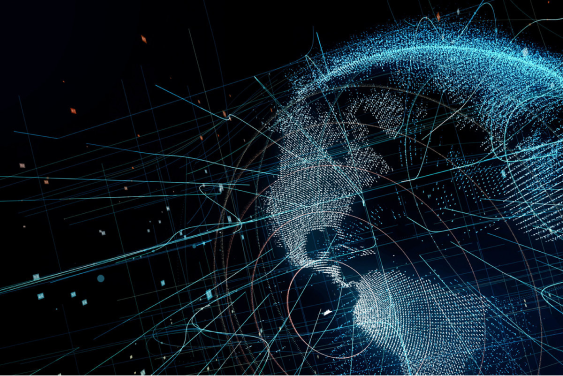I’m pretty sure a robot could have helped me accomplish 50% of tasks in my last job. Not exactly the definition of job security when talking about the future of work. According to a recent McKinsey report, the pandemic accelerated existing trends in remote work, e-commerce, and automation, with up to 25 percent more workers than previously estimated potentially needing to switch occupations.
The Fourth Industrial Revolution (sometimes called the 4IR or Industry 4.0) and the pandemic are why rapid change is being predicted among the futurists experts. 4IR is driven by four specific technology developments: high-speed mobile Internet, AI and automation, the use of big data analytics, and cloud technology. This new revolution builds on the foundations set by the first three industrial revolutions. Professor Klaus Schwab, founder and executive chairman of the World Economic Forum, said that this Fourth Industrial Revolution will be “human-led and human-centered.” So what does that mean exactly? The Centre for the Fourth Industrial Revolution defines human-led and human-centered this way, “The possibilities of new 4IR technologies, deployed appropriately, should be used as the baseline to reinvent the way we operate in the new context: everything from government services, education and healthcare, to the way business interacts and provides value to its customers.However, if not directed with purpose, the 4IR has the potential to exacerbate inequality. Human-centricity, Inclusion and Trust must be key principles guiding action - we must take proactive steps to ensure technology adoption does not heighten abuse of power, bias, wealth disparities, exclusion and loss of livelihoods.” Human-centred organizations are obsessed with the journeys taken by their customers, employees and partners. These human-centered organizations fulfill a purpose for its users, customers, and community, and focus all of their innovation and operations activities around those people.
Human-Centered Organization:
- Focuses on creating better human experiences
- Builds resilience and de-risks innovation through continuous iteration and learning
- Cares as much about the experience of its diverse, empowered teams as it does about its customers
- Intentionally, actively embeds these principles into the fabric of the organization
Source: IBM
Sounds nice right? Adopting a human centered approach isn’t just good for humanity, it’s good for business outcomes. It’s also one way to attract and retain talented employees.
Inclusion: Inclusive technology design is the practice of being empathetic and designing products that will work for everyone. When COVID shots were being scheduled using an outdated system, for example, there were articles written about the difficulty older adults had scheduling appointments.
Trust & Transparency: Trust and transparency are predicted to grow in three different areas:
- Consumers are demanding more transparency before they purchase an item. They want to know who made it, if the makers received fair labor wages and if what they are buying is ethically sourced. Innovation in retail will have the ability to be more transparent by providing information for consumers with a scan of a tag to receive the full story and background about a company and their products.
- Internally, companies will be more transparent with their employees as this is also becoming a prerequisite to attract top talent.
- With digital transformation happening at companies, there’s a higher need for more cyber security specialists - especially in small and medium sized businesses. Data security issues increase when integrating new systems. My friend earned a Harvard Certificate in Cyber Security a year ago and was able to secure a full time job five months later. It’s about how technology systems are structured and what risks need to be mitigated when it comes to cyber security. It’s not cheap to get this certificate but cybersecurity will continue to be in high demand.
I don’t think we’re taking seriously enough the threat of a world where there’s not enough well-paid work for people to do.
- Daniel Susskind
Artificial Intelligence:
By 2026, over one third of skills that are critical in today's workplace will have changed, which means competencies/skills will have changed as well. The World Economic Forum wrote, “The workforce is automating faster than expected, displacing 85 million jobs in the next five years. Automation, in tandem with the COVID-19 recession, is creating a “double-disruption” scenario for workers. Companies’ adoption of technology will transform tasks, jobs, and skills by 2025. Some 43 percent of businesses surveyed indicate that they are set to reduce their workforce because of technology integration, 41 percent plan to expand their use of contractors for task-specialized work, and 34 percent plan to expand their workforce as a result of technology integration. Five years from now, employers will divide work between humans and machines roughly equally.”
If you’re considering taking courses in AI but don’t want to code, there are different options. Many business leaders are unsure how to implement AI in order to save money for their business in the long run. There’s a course called, “AI Strategies for Business” from UC Berkeley which is four months and the main assignment is writing about how AI could be implemented at their company to be more efficient. There are courses in ethics in AI and they typically have a psychology or anthropology background and they’re comfortable analyzing data. We’ve written about AI and different certification options here.
3 Tips to Prep for 4IR:
- Get involved with nonprofits working on human centered and ethical design in technology such as All Tech Is Human to expand your network. Don’t be intimidated by their mission. Their slack group includes people from all different backgrounds globally. They also have a career channel where they share open positions that are primarily remote opportunities.
- Follow experts such as top VC firms in Silicon Valley who know what kinds of technology will be in demand and have their finger on the pulse when it comes to behavior change in consumers. They’re also aware of overall business trends and can see what products and services will win. If you’re on ClubHouse, Marc Andreesen of Andreesen Horowitz is on CH frequently and is always interesting.
- Life-long learning is mandatory. Although some companies will support employees and reskill and restrain them, it will ultimately be up to the individual to keep learning. 85 million jobs being eliminated in the next 5 years is significant. Set aside a few hours a week to explore and learn something completely different.
Here are 10 skills needed in the 4IR that include several “soft skills” in the future of work.
Here's a chart of jobs in demand and others that are decreasing in demand by the World Economic Forum 2020 Job Survey. Not surprisingly, the top five areas that are increasing in demand involve AI in some capacity. The more technology skills that are under your belt, the better. There are loads of free resources and courses to learn different skills - in order to stand out from the crowd and to prevent a robot from taking over everyday tasks.
Reviewed & Recommended:
4IR Video by World Economic Forum
World Economic Forum: What will the future of jobs be like?
The future of work after COVID-19 | McKinsey
| MORE ARTICLES
Emily’s vision for illume hire developed as part of her journey from a startup-curious sales and media professional to co-founder and CEO. Her passion is to provide resources to support professionals with 20+ years experience. Emily was part of the founding leadership team of Age Equity Alliance, a non-profit focused on the benefits of an intergenerational team.


